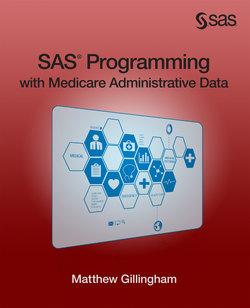Читать книгу SAS Programming with Medicare Administrative Data - Matthew Gillingham - Страница 4
На сайте Литреса книга снята с продажи.
ОглавлениеContents
About This Book
About The Author
Acknowledgments
Chapter 1: Introduction
Introduction and Purpose of This Book
Framework of This Book
Our Programming Project
Chapter Outline
How to Use This Book
Disclaimer
Chapter Summary
Chapter 2: An Introduction to the Medicare Program
Introduction and Goals of the Chapter
An Introduction to the Medicare Program
What is Medicare?
Medicare Enrollment and Eligibility
What Is Covered by Medicare?
What Is Not Covered by Medicare?
The Mechanics of Medicare
Chapter Summary
Chapter 3: An Introduction to Medicare Data
Introduction and Goals of This Chapter
A Note on the Source and Structure of Our Claims Data
Part B Carrier Claims Data
Durable Medical Equipment (DME) Data
Outpatient Claims Data
Inpatient Claims Data
Skilled Nursing Facility (SNF) Claims Data
Home Health Claims Data
Hospice Claims Data
Commonly Retained Elements in Administrative Claims Data
Master Beneficiary Summary File
Provider Data
Example: Identification of Emergency Department (ED) Utilization
Example: Identification of Surgical Services
Chapter Summary
Chapter 4: Planning the Research Programming Project
Introduction and Goals of This Chapter
Our Project’s Plan: The SDLC
Our Project’s High-Level Requirements
Our Project’s Quality Assurance Plan
Our Project’s Flowchart
Our Project’s Data Storage and LIBNAMES
Our Research Programming Technical Specifications
Chapter Summary
Chapter 5: Request, Receive, Load, and Transform Data
Introduction
Requesting Medicare Administrative Claims and Enrollment Data
Sources of Medicare Claims and Enrollment Data
Data Available from CMS
Our Project’s Data Requirements and Request Specifications
Contacting ResDAC and Completing Paperwork
Receiving, Decrypting, and Loading Medicare Administrative Claims and Enrollment Data
Receiving Our Medicare Administrative Data
Decrypting Our Medicare Administrative Data
Loading Our Medicare Administrative Data into SAS Data Sets
Algorithms: Transforming Base Claim and Line Level Data Sets into Single Claim-Level Files
Transforming Base Claim and Line-Level Carrier Data into a Claim-Level File
Chapter Summary
Chapter 6: Working with Enrollment Data
Introduction and Goals
Review and Approach
Basics of Medicare Enrollment Data
Our Programming Plan
Algorithms: Identifying Continuously Enrolled FFS Beneficiaries
Why Define Continuously Enrolled FFS Beneficiaries?
How to Specify the Programming for Continuous Enrollment in Medicare FFS
Medicare Part A and Part B Enrollment Variables
HMO Coverage Variable
Date of Death Variable
How to Program in SAS to Define Continuous Enrollment in Medicare FFS
Algorithms: Create or Retain Data Elements for Displaying Results by Certain Characteristics
Coverage Characteristics, Month of Death, Sex, and Race
Age Groups
Geographic Characteristics
Algorithms: Create Final Enrollment Data for Remainder of Programming
Chapter Summary
Exercises
Chapter 7: Measuring Utilization of Services
Introduction and Goals
Review and Approach
Review: Basics of Medicare Claims Data
Our Programming Plan
Algorithms: Delimit Claims by Continuously Enrolled Beneficiary Population
Algorithms: Measuring Evaluation and Management (E&M) Utilization
Algorithms: Measuring Inpatient Hospital Utilization
Algorithms: Measuring Emergency Department Utilization
Algorithms: Measuring Utilization of Ambulance Services
Algorithms: Measuring Outpatient Visit Information
Algorithms: Measuring Utilization of SNF, Home Health Agency, and Hospice Care
Chapter Summary
Exercises
Chapter 8: Measuring Costs to Medicare
Introduction and Goals
Review and Approach
Review: Basics of Medicare Cost
Our Programming Plan
A Note on Payment Standardization and Risk Adjustment
Algorithms: Measuring Evaluation and Management Payments
Algorithms: Measuring Inpatient Hospital Payments
Algorithms: Measuring Total Part A Payments
Chapter Summary
Exercises
Chapter 9: Programming to Identify Chronic Conditions
Introduction and Goals
Review and Approach
Review: Peculiarities of Medicare Data
Our Programming Plan
A Note on the Chronic Conditions Data Warehouse (CCW)
Algorithms: Identifying Beneficiaries with Diabetes or COPD
Algorithms: Evaluation and Management Visits for Beneficiaries with Diabetes or COPD
Algorithms: Diabetic Eye Exams for Beneficiaries with Diabetes
Algorithms: Hospital Readmissions for Beneficiaries with COPD
Chapter Summary
Exercises
Chapter 10: Presenting Output and Project Disposition
Introduction
Synthesis – Review and Approach
Review: Our Accomplishments
Our Programming Plan
Algorithms: Presenting Selected Measurements of Utilization, Cost to Medicare, and Quality Outcomes
Presenting Ambulance Utilization
Presenting Medicare Payments for Evaluation and Management Services by Provider
Presenting Rates of Diabetes and COPD
Algorithms: Presenting Inpatient Length of Stay Information by State
Algorithms: Presenting Mean Medicare Part A Payments per Beneficiary by State and County
Algorithms: Presenting Rates of Diabetic Eye Exams
Production Execution in Batch
Project Disposition
Archiving Materials for Future Use
Data Destruction
Chapter Summary
Exercises
Index
